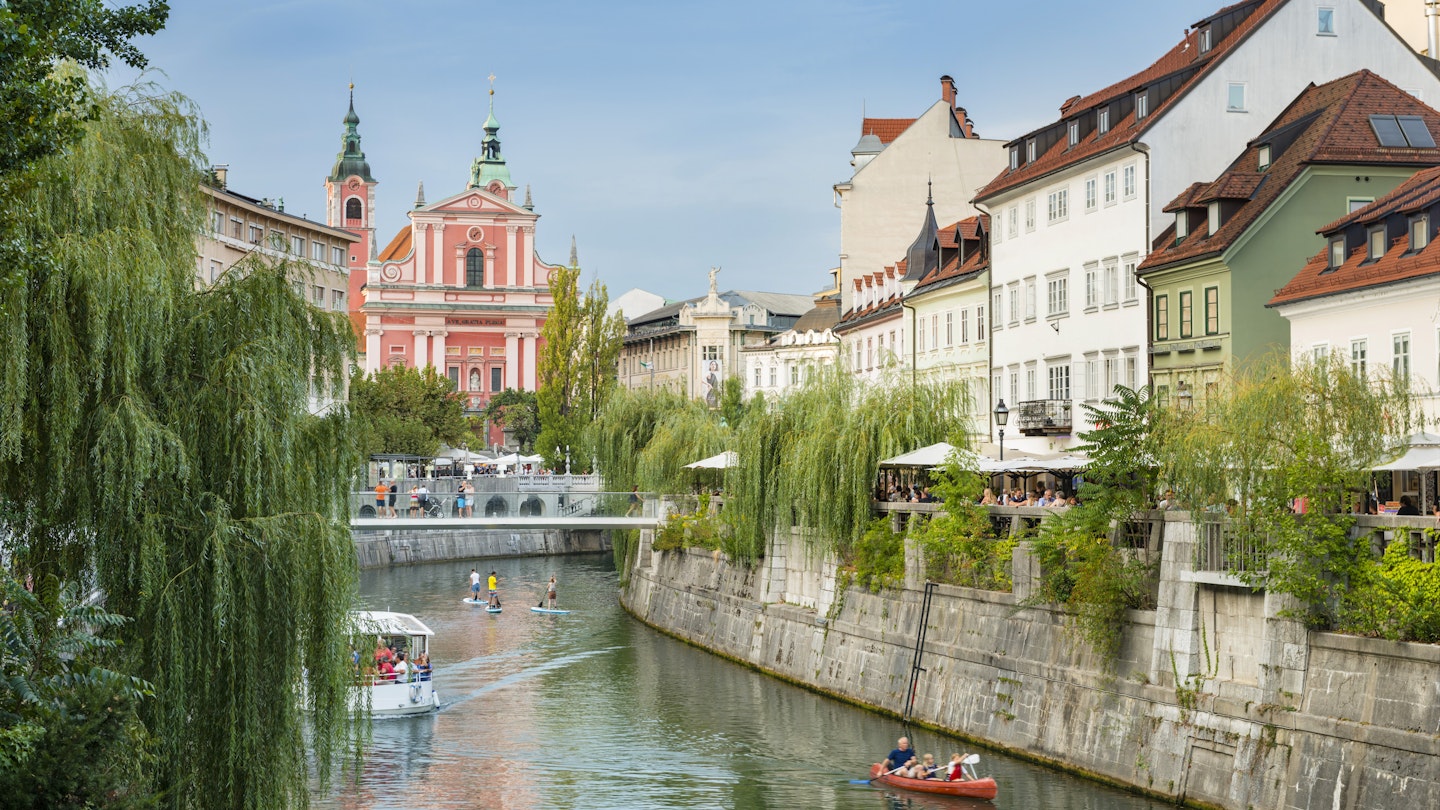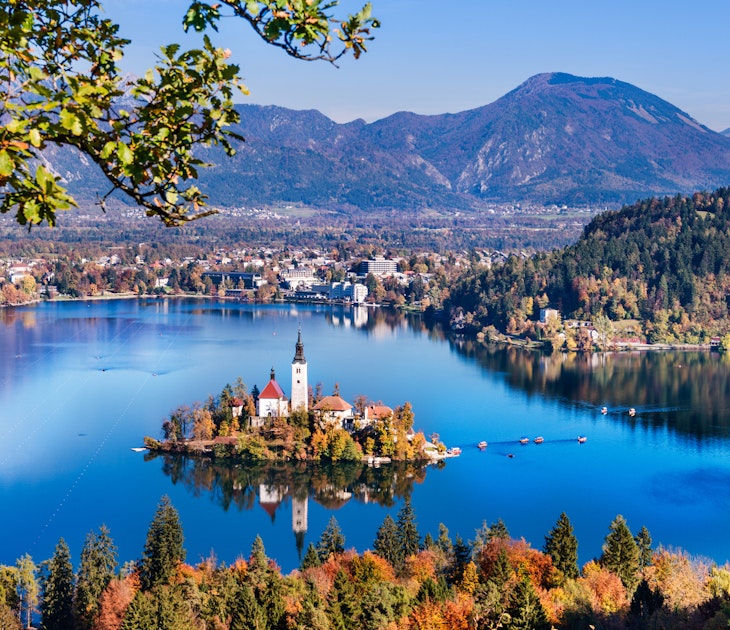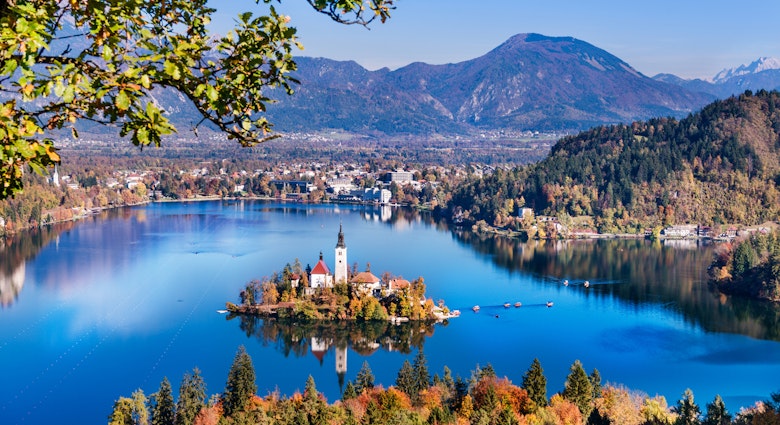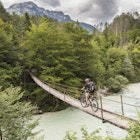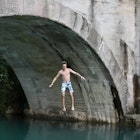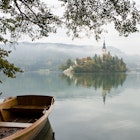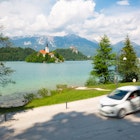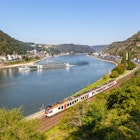For proof that good things come in small packages, one need only visit Slovenia. In an area half the size of Switzerland, this Central European country packs in breathtaking mountain scenery, lively coastal resorts, fashionable cities, crystal-clear lakes and rivers, and charming, isolated villages.
Better still, because of this compact size, you can take in most or all of these delights within the course of one trip. In the span of a few days, you can walk in the Alps, kayak a glacial waterway, visit some world-class winemaking regions, and take a dip in the sea. Don't worry if you're not able to name many cities, regions or landmarks in this stunning country. Slovenia – hiding in plain sight – is waiting to be explored.
1. Ljubljana
Best for spectacular architecture
All roads in Slovenia lead to the capital, and not just because it’s situated in the center of the country. Ljubljana buzzes with active, cycle-riding residents, alternative culture and eclectic restaurants, museums and cafes. However, the setting alone is worth a visit – every square features stunning architecture that reveals the city’s history in stone and eye-catching ornamentation.
Start your investigation at the fairytale-like Ljubljana Castle, an ancient hilltop fortification whose origins date back to the 12th century. You can either hike a short but steeply inclined path to the top or take the funicular. Once there, poke around old medieval rooms that have been preserved and take in attractions like the Slovenian History Exhibition or Museum of Puppetry.
Make your way back to the Old Town to admire the main square, Prešernov Trg, and its baroque, salmon-pink 17th-century Franciscan Church of the Annunciation. Several buildings here sport beautiful art nouveau and secessionist facades from the early 20th century.
Fans of early-modern architecture will want to scout out the works of native son Jože Plečnik, a gifted architect who bequeathed several breathtaking bridges and buildings to the city during the first half of the 20th century. Many of his creations, including the dazzling Triple Bridge and the interior of the National & University Library, are UNESCO-protected works of cultural heritage.
2. Lake Bled
Best for a romantic holiday
Whether you know it or not, you’ve likely seen Lake Bled before. The image of a seemingly mythical church standing in the middle of a turquoise lake is Slovenia’s most iconic image. Even in two dimensions, this magical place pulls at your heartstrings. When you see it in person, with that special someone by your side, get ready for fireworks.
Begin with a sunrise walk around the lake, about 5km and almost entirely flat. Three footpaths signposted "Grad" lead toward Bled Castle; each one involves a climb but it's worth it for the views. Then visit magical, tiny Bled Island in the middle of the lake. Board a pletna, a wooden boat that resembles a Venetian gondola, and head over to climb the 99 stairs into the Church of the Assumption of Mary.
No romantic outing here is complete without an easy hike to Vintgar Gorge, around 4km from the center of town. Boardwalks and bridges take visitors on an intimate journey across the magical 1600m-long ravine.
Planning tip: Buy tickets for Vintgar Gorge in advance. Entry is staggered to protect the gorge; pets are also welcome by purchasing a special ticket.
3. Lake Bohinj
Best for experiencing local culture
For a small country, Slovenia boasts a surprising amount of regional variation. The communities surrounding pristine Lake Bohinj – Slovenia’s largest natural lake, tucked into the Triglav National Park – truly lean into their regional identity. You’ll find makers here of everything from distinct dairy and cheese products to meats, honey, jam and even gin. To make it easier to find the genuine article, look for the “Bohinjsko” (from Bohinj) label signifying it’s locally produced.
Hike out into the rural hamlets north of the lake to learn more about local lifestyles. At the Alpine Dairy Farming Museum in Stara Fužina, exhibits explain how farm-to-table is more than just a dining trend – the locals are passionate about their heritage. Give in to the temptation to sip on whatever is handed to you and just listen.
Bohinj comes into its own in summer when you can swim or sail on the lake and hike or bike into the national park. Once you’re ready to travel again, board the scenic Bohinj Railway and ride it from the station at Bohinjska Bistrica all the way to Italy.
Planning tip: Lake Bohinj is lovely in springtime when the annual International Wildflower Festival allows you to experience the region from the roots up. Learn more about the magical activities in the area with our insider guide to Lake Bohinj.
4. Maribor
Best for peeling back layers of history
Maribor could fit into several “best of” categories. Slovenia’s second-largest city anchors the country's Podravska wine region and has a thriving gourmet scene, including some of the country’s best restaurants. Plus, because it sits on the Drava River, it's a hub for adventure activities like rafting, cycling and hiking. But Maribor is, at its heart, a treasure chest of historic layers.
Settled time and again during the Stone Age, Celtic period and Roman era, the modern city dates back to the Middle Ages. First, stop in at Maribor Castle, home of the regional museum, to get a historical overview and then explore the main medieval market square, Glavni Trg.
Here, you’ll see the 16th-century Town Hall before taking a seat to enjoy a glass of wine at the Old Vine House, where the world’s oldest producing vine — more than 400 years old — climbs the facade and still produces vino. If you want to stretch your legs some more, hike 30 minutes out to an ancient, 12th-century castle known as Piramida.
Planning tip: Two excellent restaurants to try are Hiša Denk and Restavracija Mak. Book your table well in advance, particularly during the high season.
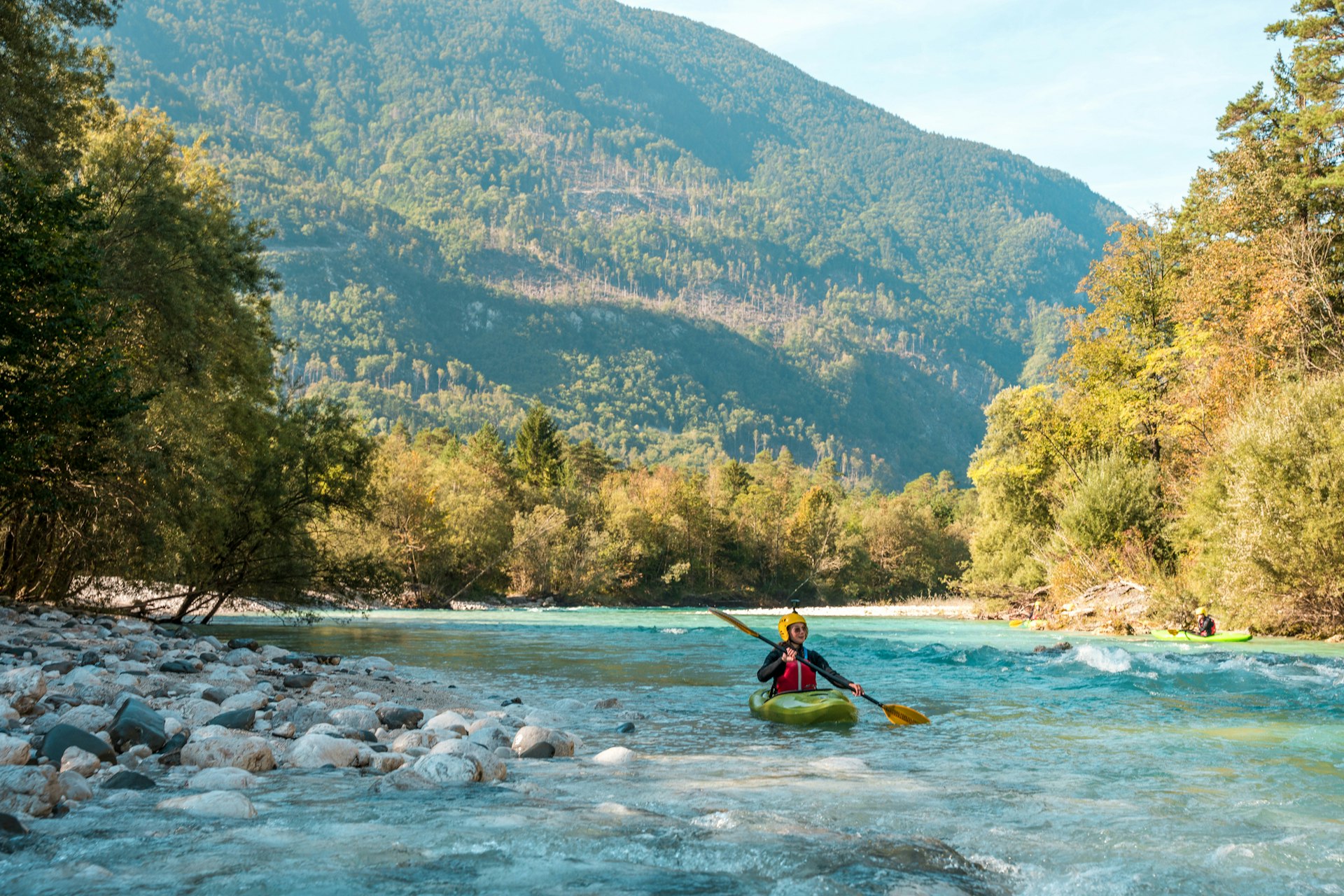
5. Bovec
Best for outdoor adventure
At the edge of Triglav National Park, squeezed between the Julian Alps and the crystal-clear turquoise Soča River, Bovec is a haven for water-based activities. The frothy river, boasting unimaginable cerulean shades that come from the underlying bedrock itself, is just as stunning as you’ve heard and neither picture nor rumor does it justice.
The best way to experience the river is to join a white-water rafting or kayaking tour (they run from March to October). Canyoning – where groups make their way down a mountain stream in a gorge with techniques like abseiling, climbing, sliding and jumping – is gaining ground too. Bovec offers zip lining over the Julian Alps, with more than 3km of lines at the Adrenalin Park Bovec.
In winter, skiing is king, and nowhere is more popular than the Kanin Ski Centre. The biggest ski area in Slovenia shares custody with Italy, and the starting point for the gondola is in Bovec. Hit the slopes and watch the sea below.
Planning tip: Several rafting companies offer excursions for beginners and experts, including Nature's Ways and Kayak Soča.
6. Karst Region
Best for landscapes and caving
Slovenia’s Karst Region, which takes its name from its porous, limestone topography, is home to some of Europe’s largest and most-stunning cave systems. Two caves in particular, Postojna and Škocjan, stand out but the karst is riddled with dozens of underground attractions. Postojna Cave, one of the world's largest, features unparalleled stalagmite and stalactite formations. Once inside, take a 1.5-hour tour that unveils 5km of the expansive cave. More than half the journey is covered by a cool electric underground train.
The immense complex of the Škocjan Caves, 20km southwest of Postojna, is, if anything, more spectacular. The entire system was created by the Reka River, which carved its way over the millennia through a gorge beneath Škocjan village.
Planning tip: Aside from underground treasures, the Karst’s deep green hills are rich in fruits, ruby-red teran wine, pršut (dry-cured ham), and lots of picturesque villages with old stone churches.
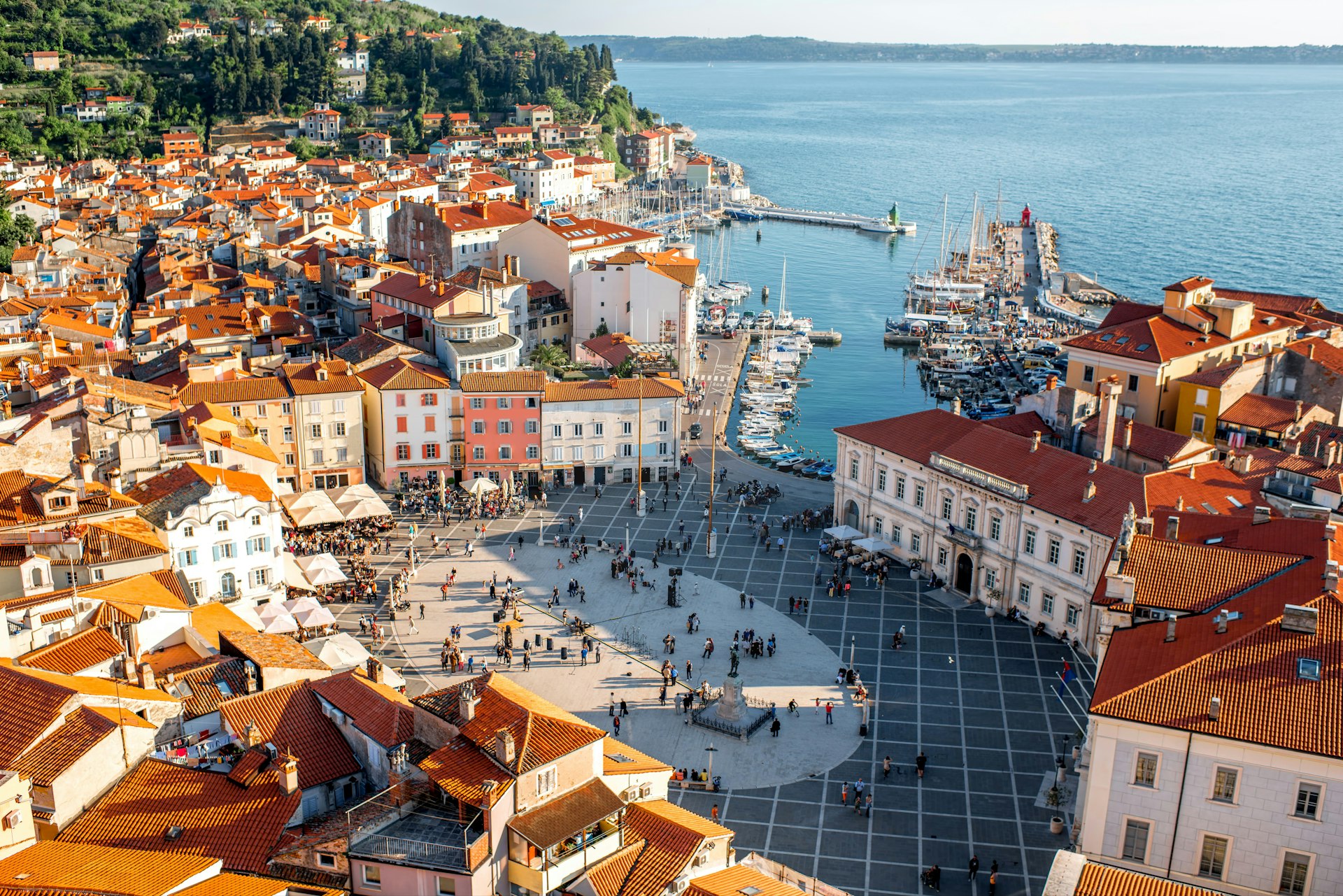
7. Piran
Best for soaking up the sun
Such is the bounty of Slovenia that you can play in the mountains in the morning and lounge on the beach in the afternoon. When that urge strikes, Piran is the spot to soak up the rays, splash in the Adriatic and discover a unique destination along the country’s tiny 47km long coastline.
Often called the most beautiful town along the Slovenian Adriatic, Piran predates the Romans but got its present look in the Middle Ages as part of the Venetian Empire. Get a panoramic overview by climbing the stairs to the top of the bell tower, next to the 17th-century baroque Cathedral of St George. From here, you'll be able to see three countries at once.
Come down from your perch to Tartinijev Trg, the town’s nerve center, before heading to the Mediadom Pyrhani, a museum that offers a multimedia take on Piran history. But don't forget the reason you’ve come – a 15-minute walk takes you to Fiesa Beach for your cooling plunge into the sea.
Planning tip: The nearby Strunjan Landscape Park, east of Piran, offers two secluded (and harder-to-reach) beaches: Moon Bay and Bele Skale.
8. Goriška Brda
Best for sampling wines
Straddling the Italian border, Goriška Brda (or simply “Brda") is an absolute charmer: rolling hills lined with grapevines and sun-kissed orchards topped with small settlements and churches. The area is one of Europe's best-kept secrets. From one of the many perched villages scattered across the fertile hillsides, you’ll see a seemingly endless expanse of vineyards disappearing over the horizon.
A paradise for cyclists, the hills of Goriška Brda are home to dozens of scenic trails that are great for exploring on two wheels. Wineries to look out for include Klet Brda, the largest wine producer in Slovenia, with a well-stocked wine shop at its Dobrovo estate and excellent daily tours, Vinoteka Brda, and Edi Simčič, a third-generation family estate with tastings almost every day.
Planning tip: Like elsewhere in Slovenia, most local wine producers require visitors to call or book ahead to arrange a tasting.


